Crispy Sesame Ball Recipe kicks off this flavorful journey through one of Asia’s most beloved sweets. Right from the first bite, you’ll meet a crunchy sesame-coated shell that gently yields to a soft, chewy layer—only to be rewarded with a creamy, sweet center of lotus or red bean paste. That magical bite is exactly what inspired us here at Cooking Flash. If you’ve peeked at our About Page, you know our story began with a mission: to master the perfect crispy texture across all cuisines. This sesame ball recipe? It’s a tribute to that mission—tested, refined, and perfected for your home kitchen.
This guide is all about helping you create the best crispy sesame ball recipe—and not just any version, but one that captures the authentic feel of Chinese pastry stalls, yet stays easy enough for a weeknight dessert. Whether you’re after a giant sesame ball recipe to impress your guests, or experimenting with a sesame balls no filling alternative, this walkthrough gives you everything.
Throughout the article, you’ll naturally find answers to popular questions like “What’s in a sesame ball?”, “What is buchi made of?”, or even “Are fried sesame balls good for you?” We’ll also compare the Chinese sesame balls recipe with regional twists, explore different fillings like sweet red bean or lotus paste, and give you reliable frying tips to avoid soggy or bursting dough.
For dessert lovers, don’t miss our Soft Chewy Raspberry Sugar Cookies for another chewy-crisp indulgence. Craving a tropical treat? Discover great ideas like Crustless Coconut Pie. Looking for something crunchy and quick? Check out No Bake Chocolate Quinoa Crunch Clusters. And if you want to add a savory twist to your menu, don’t miss our Doritos Cheesy Chicken Casserole.
Table of Contents
Table of Contents
Introduction – The Charm of the Crispy Sesame Ball Recipe
The About Page Story: Our Journey into Asian Pastry Magic
At Cooking Flash, we didn’t just stumble upon the crispy sesame ball recipe—we earned it through months of trial, error, and flavor obsession. Our kitchen began as a small experiment space for Asian-inspired sweets, and this recipe was one of the first challenges we fully embraced. From the beginning, our goal was simple: bring street food-style authenticity into everyday kitchens. Inspired by traditional Chinese bakeries and the nostalgic aromas from dim sum carts, we rolled, fried, and tested endlessly until each ball came out perfectly crisp on the outside and irresistibly tender inside.
If you’ve ever browsed our About page, you know we’re all about flavor-meets-simplicity. And this recipe? It captures that mission bite by bite.
Why This Easy Crispy Sesame Ball Recipe Is a Must-Try
This isn’t just a dessert—it’s a sensory experience. You get a crunchy sesame crust, a soft layer of mochi-like dough, and a sweet lotus or red bean center that melts in your mouth. Whether you’re prepping for Lunar New Year, craving a nostalgic childhood treat, or discovering Asian desserts for the first time, this recipe delivers the perfect mix of textures and flavors.
Unlike many fried pastries, this one is light on the oil taste and big on satisfaction. The ingredients are simple—glutinous rice flour, sugar, water, and a rich filling—yet the results feel gourmet. Best of all, it’s customizable. From classic red bean paste to creative chocolate twists, this sesame ball can be adapted to your style and taste.
And if you’re thinking this sounds too advanced—don’t worry. We’ve broken the steps down so anyone, from first-time fryers to seasoned bakers, can succeed.
Quick Origins of Crispy Sesame Ball Recipe (Jian Dui or Buchi)
Known in Mandarin as jian dui and in the Philippines as buchi, these crispy sesame balls have a history that spans centuries. They’re a staple at Chinese bakeries and often symbolize luck and prosperity during festive seasons like Lunar New Year.
The dough is made from glutinous rice flour, which gives it that chewy bite, while the filling—often lotus paste or sweet red bean—offers an earthy sweetness that complements the crispy shell. Once shaped and coated with sesame seeds, they’re deep-fried to golden perfection.
It’s easy to see why foodies are searching for terms like easy crispy sesame ball recipe or even giant sesame ball recipe. There’s something universally satisfying about watching them puff up in the fryer, knowing a treat of warm sweetness awaits.
Print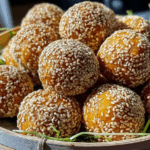
Unbelievably Easy Crispy Sesame Ball Recipe You’ll Regret Not Trying
- Prep Time: 45 minutes
- Cook Time: 20 minutes
- Total Time: 1 hour 5 minutes
- Yield: 8 sesame balls
- Category: Dessert
- Method: Deep Frying
- Cuisine: Chinese
- Diet: Vegetarian
Description
These crispy, golden Chinese sesame balls (Jian Dui) are filled with sweet lotus or red bean paste, coated in sesame seeds, and deep-fried to perfection. A popular dim sum treat, they have a chewy interior and a nutty, crunchy exterior.
Ingredients
- 1 1/2 cups glutinous rice flour (divided)
- 1/3 cup granulated sugar
- 1/4 cup boiling water
- 1/4 cup room temperature water (plus 1 tablespoon)
- 7 ounces lotus paste or red bean paste
- 1/4 cup sesame seeds (raw or toasted)
- 4 cups peanut or vegetable oil (for frying)
Instructions
- Choose your filling: Use store-bought or homemade lotus or red bean paste. Roll into 8 balls, 24g each.
- Make the dough: Mix 1/2 cup glutinous rice flour and sugar with boiling water. Let sit 5 minutes. Add remaining glutinous rice flour and room temp water. Mix until dough forms. Cover and rest for 30 minutes.
- Prepare sesame seeds: Rinse and drain sesame seeds, then spread on a plate. They should be moist but not dripping wet.
- Divide dough: Weigh dough (about 370–380g) and divide into 8 equal pieces (approx. 47g each). Roll into balls.
- Assemble: Flatten each dough ball to 3 inches wide. Place filling in center and wrap dough around it. Seal and roll into smooth balls.
- Coat: Roll each ball in moistened sesame seeds, then roll in hands to press seeds into the surface. Set on parchment paper.
- Fry: Heat oil to 320°F (160°C). Add 4 balls, stir gently with slotted spoon. Maintain temp at 300°F (150°C). After 10 minutes, balls float.
- Brown: Raise temp to 350°F and fry for 5 more minutes until golden. Total fry time: 17–18 minutes.
- Drain and cool: Remove to a paper towel-lined plate or cooling rack. Repeat with remaining balls. Cool for 10 minutes before serving.
Notes
- Make sure dough is evenly wrapped to avoid bursting during frying.
- Maintain steady oil temperature for perfect texture and color.
- Can use toasted sesame seeds for a nuttier flavor.
- Best served fresh, but can be reheated in an oven.
Nutrition
- Serving Size: 1 sesame ball
- Calories: 260
- Sugar: 8g
- Sodium: 35mg
- Fat: 10g
- Saturated Fat: 1g
- Unsaturated Fat: 8g
- Trans Fat: 0g
- Carbohydrates: 39g
- Fiber: 1g
- Protein: 3g
- Cholesterol: 0mg
Sesame Balls Ingredients Breakdown for Crispy Sesame Ball Recipe
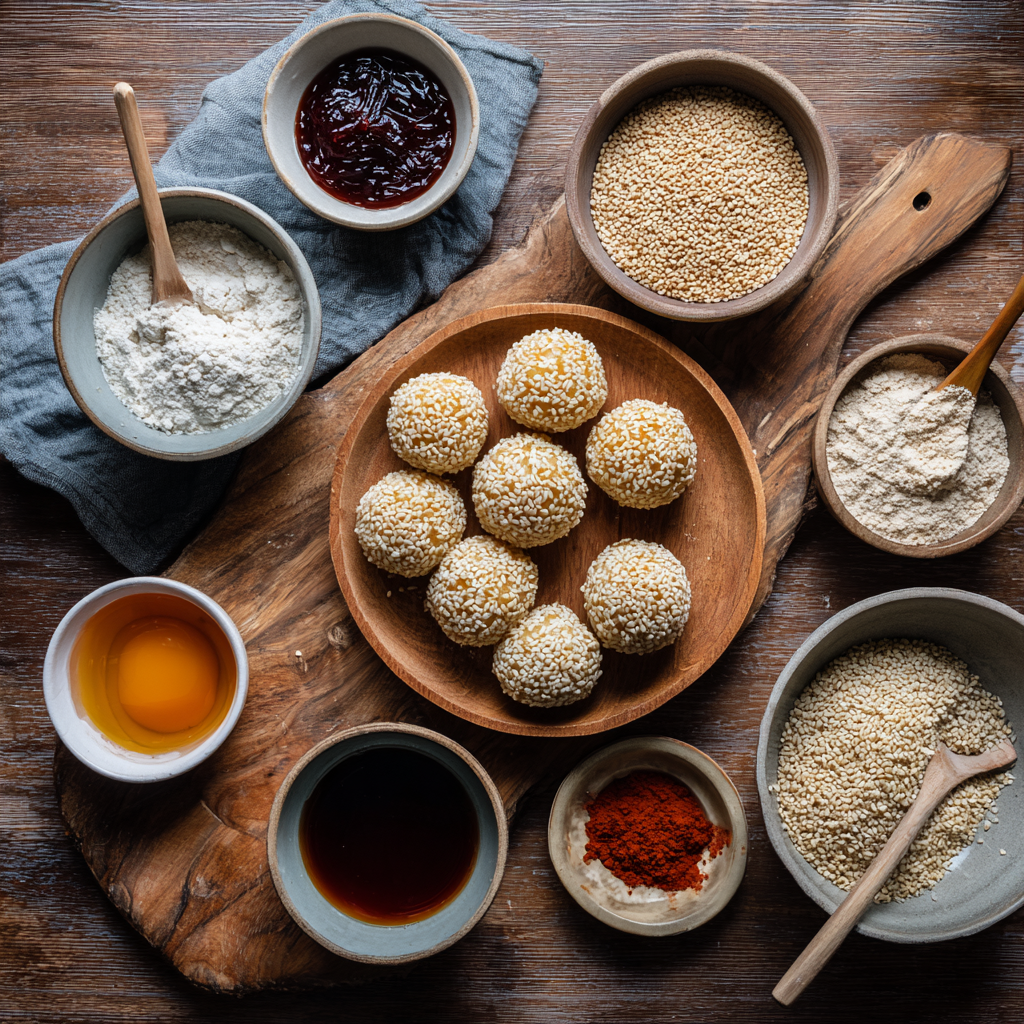
Essential Ingredients and Their Functions for Crispy Sesame Ball Recipe
Creating the perfect crispy sesame ball recipe starts with understanding each ingredient and what it brings to the table. While this snack may look simple, every component plays a critical role in achieving that crunchy-on-the-outside, chewy-on-the-inside experience.
Here’s what you’ll need:
- Glutinous Rice Flour (1 ½ cups): This is the base of the dough. It’s not regular rice flour—glutinous rice flour gives the dough its signature sticky, elastic texture. It’s what makes the outside crisp but the inside chewy and tender once fried.
- Granulated Sugar (⅓ cup): Aside from sweetening the dough slightly, sugar helps with the browning during frying. It also balances the neutral flavor of the rice flour.
- Boiling Water (¼ cup): Hot water is used initially to partially “cook” a portion of the flour, forming a pre-gelatinized dough that makes it easier to shape and roll later.
- Room Temperature Water (¼ cup + 1 tbsp): Added after the hot water step to cool the dough and finish combining the remaining flour. This helps form a smooth, pliable dough.
- Filling – Lotus Paste or Red Bean Paste (7 oz): This is the sweet surprise in the center. Traditionally, these pastes are made by simmering and sweetening mashed lotus seeds or red beans. They offer a soft, earthy contrast to the crisp shell.
- Raw or Toasted Sesame Seeds (¼ cup): These coat the outside of each ball and toast up beautifully during frying, adding both flavor and crunch. They also provide that iconic nutty aroma.
- Peanut or Vegetable Oil (4 cups): A neutral oil with a high smoke point is ideal for deep frying. It ensures the sesame balls puff evenly without burning.
Looking for more ideas using lotus paste or red bean paste? Discover great ideas like our Crustless Coconut Pie which pairs well with any sweet filling.
Ingredient Sourcing Tips: What You Need and Where to Get It for Crispy Sesame Ball Recipe
Not all ingredients in this recipe are pantry staples, but don’t worry—they’re easy to find with a little guidance
- Glutinous rice flour can be found in the Asian aisle of major supermarkets, or at Asian grocery stores. Look for brands like Mochiko or Erawan, which are widely trusted.
- Lotus paste and red bean paste are typically sold canned or vacuum-sealed at Asian markets. You can also make your own if you prefer full control over sweetness and texture.
- Sesame seeds can be bought in bulk. Choose untoasted if you want more control over color and flavor during frying. If using toasted, expect a slightly darker finish.
- Peanut oil is often recommended for frying due to its neutral flavor and heat stability. If you prefer a more budget-friendly option, vegetable oil works just as well.
Some readers have asked, “What are the ingredients in a sesame ball?” Now you know! Each one serves a specific purpose, and with the right sourcing, your sesame balls will turn out just like the ones in your favorite Chinese bakery.
LSI Integration: sesame balls ingredients, lotus paste, glutinous rice flour
When it comes to crafting the best crispy sesame ball recipe, it’s not just about technique—ingredients matter deeply. The flavor of your filling, the freshness of your flour, even the type of sesame seeds used—all impact the end result. If you’re on a tighter budget or just want to try a faster version, consider a sesame balls no filling variation. Simply skip the paste and proceed with the dough and sesame coating. They’re still delicious, especially when dipped in a honey-sesame sauce or dusted with powdered sugar.
Step-by-Step Crispy Sesame Ball Dough Preparation
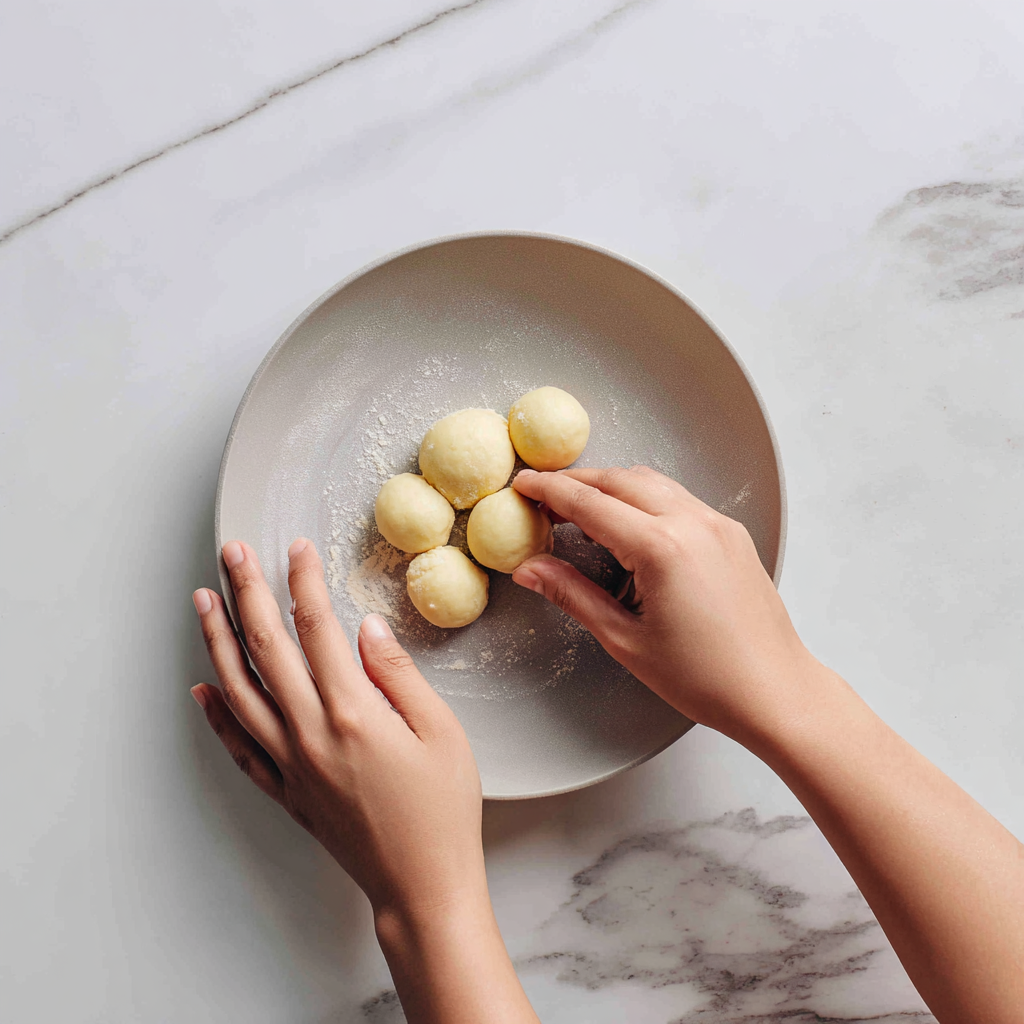
Mixing the Dough to the Right Consistency for Crispy Sesame Ball Recipe
The secret to the perfect crispy sesame ball recipe starts with a dough that’s smooth, elastic, and just sticky enough to hold together—but not so wet that it collapses during frying. Getting that right balance begins with a unique method that blends hot and cold water into the glutinous rice flour, activating the starches and creating a bouncy, pliable dough.
Here’s how to do it:
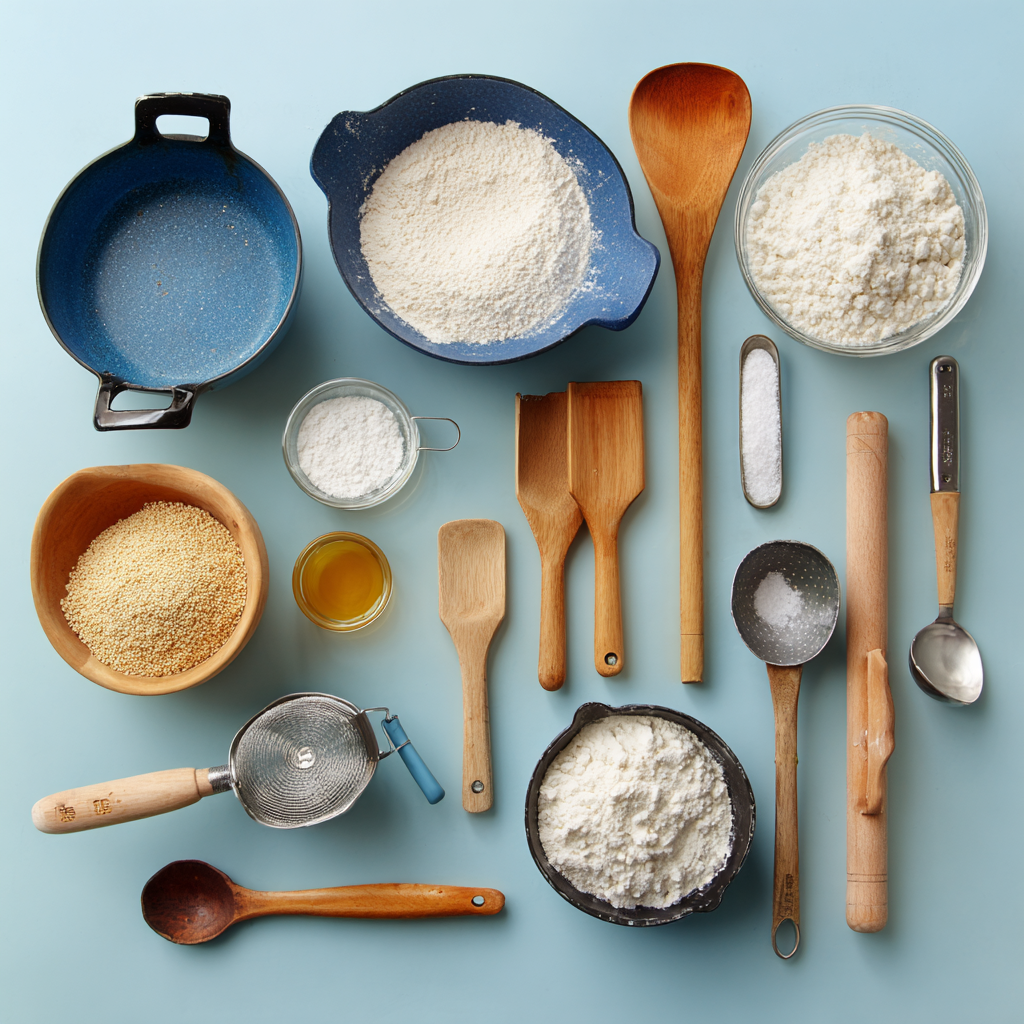
- Start with a pre-cook base: In a mixing bowl, combine ½ cup of glutinous rice flour with ⅓ cup of granulated sugar. Carefully pour in ¼ cup of boiling water and mix with a rubber spatula until it forms a sticky, partially-cooked paste. This step gives the dough structure.
- Let it rest: Cover and let the mixture sit for 5 minutes. This short rest allows the hot water to gelatinize the flour, making it easier to absorb the next batch of liquid.
- Incorporate the remaining flour: Add the remaining 1 cup of glutinous rice flour and slowly stream in ¼ cup plus 1 tablespoon of room temperature water. Mix thoroughly until all the flour is hydrated.
- Form a smooth dough: At this point, use your hands to knead the dough in the bowl or on a clean surface. It should feel soft, slightly tacky, and pliable—similar to playdough. If it feels too dry, add a splash more water. Too wet? Sprinkle in a teaspoon of flour.
- Rest again: Shape the dough into a ball, cover it with an overturned bowl or place it inside a reusable silicone bag. Let it rest for 30 minutes. This resting period helps relax the dough and ensures an even fry later.
If you’ve followed these steps, you now have the ideal dough foundation for your sesame balls. The mix of hot and cold water may sound unusual, but it’s what gives the final product that golden crisp without cracking or bursting.
Dough Resting: Why It Matters for That Signature Crisp for Crispy Sesame Ball Recipe
It’s tempting to rush to the next step, but don’t skip the resting period. During this time, moisture redistributes evenly throughout the dough, making it more cohesive and easier to work with.
Skipping this rest can lead to:
- Uneven frying
- Cracks in the outer shell
- Over-stretching when filling
With this rest, the dough develops elasticity—important for wrapping the filling tightly and keeping the sesame balls sealed during frying. If you’re in a rush, even a 15-minute rest helps more than none at all.
Alternative Tip: Making Crispy Sesame Ball Recipe With No Filling
For those who want a lighter or quicker version of this snack, you can absolutely make sesame balls with no filling. Instead of stuffing the dough, roll them into smaller bite-sized pieces and coat directly in moistened sesame seeds. These puff up just like the traditional version and are great for dipping or dusting with powdered sugar. Plus, they reduce prep time significantly and make for a fun party snack.
And yes, these are still considered part of the best crispy sesame ball recipe category—especially when served with a sweet dipping sauce or drizzled with honey.
Looking for more simplified desserts? Don’t miss our No Bake Chocolate Quinoa Crunch Clusters for another quick-fix favorite.
Sweet Center Secrets – The Filling You’ll Crave
What’s in the Middle of a Crispy Sesame Ball Recipe?
If you’ve ever bitten into a sesame ball and wondered what makes the inside so deliciously smooth and sweet, here’s your answer—it’s usually lotus paste or red bean paste, both traditional fillings with deep cultural roots in Asian desserts. These fillings are not just sweet for sweetness’ sake—they bring warmth, richness, and an earthy undertone that balances the crispy shell beautifully.
So, what’s in the middle of a Crispy Sesame Ball Recipe? In most cases, it’s a sweetened paste made from lotus seeds or adzuki beans. These ingredients are simmered, blended, and sweetened to a creamy consistency that’s easy to roll and stuff. Whether you’re making Chinese sesame balls recipe or Filipino-style buchi, the center is where the flavor magic happens.
Choosing Between Lotus Paste and Red Bean Paste
While both fillings are traditional, they have their own charm:
- Lotus Paste: Smooth and buttery, lotus paste has a subtle, floral sweetness. It’s considered more decadent and is commonly used in mooncakes and celebration desserts. It’s the go-to if you want that classic, almost custard-like center.
- Red Bean Paste: Slightly more textured than lotus paste, red bean (made from adzuki beans) is earthy and slightly nutty. It’s less sweet than lotus paste, making it a great option if you prefer balance over richness.
Pro tip: These fillings are often sold in sealed packages at Asian grocery stores, but if you want total control, you can make your own at home. This allows you to adjust the sweetness and even add extras like coconut milk or vanilla.
Using a kitchen scale, measure out eight 24-gram balls of paste. This ensures uniform filling inside each dough ball, helping the sesame balls cook evenly and puff properly during frying.
Making It Your Own: Creative Filling Twists
Though traditional fillings are timeless, modern cooks love to experiment. You can easily adapt the crispy sesame ball recipe to include fun, unexpected centers. Here are a few creative twists:
| Alternative Filling Ideas | Flavor Profile |
|---|---|
| Peanut Butter & Honey | Creamy, nutty, with mild sweetness |
| Nutella or Chocolate Chips | Rich and gooey when warm |
| Sweetened Coconut Flakes | Tropical and chewy |
| Custard or Egg Yolk Paste | Dense and indulgent |
You can also combine fillings—try a red bean and chocolate swirl or peanut butter with chopped dates. Just keep in mind that the filling should be firm enough to roll into a ball and hold its shape during frying.
Still wondering “What is buchi made of?” It’s glutinous rice flour on the outside and a soft paste inside—usually lotus or red bean. But with the freedom of home cooking, it can be anything you like.
Looking for inspiration? Try our Soft Chewy Raspberry Sugar Cookies if you love surprises hidden inside treats.
Assembling and Rolling the Sesame Balls Perfectly
Mastering the Shape: Step-by-Step Assembly for Crispy Sesame Ball Recipe
Now that your dough is rested and your sweet filling is portioned, it’s time to assemble your crispy sesame balls. This step brings everything together, transforming dough and filling into those iconic golden bites.
Begin with precision: Weigh your entire dough batch—it should be close to 375 grams. Divide that by eight to get individual dough portions around 47 grams each. Do the same with your filling—24 grams per ball will give the ideal balance of dough-to-filling.
Let’s build each sesame ball:
- Form the dough wrapper: Take one portion of dough and flatten it gently into a circular disc, about 3 inches in diameter. Make sure the center is slightly thicker than the edges—this helps prevent cracking while frying.
- Add the filling: Place a lotus or red bean paste ball in the center. Carefully bring the dough edges up and around the filling, pinching them at the top to seal completely.
- Smooth the ball: Roll the filled dough gently between your palms until it’s round and even. This rolling action not only makes the ball look perfect, it also helps seal any weak spots that could open during frying.
It’s key that the filling is centered and the dough is evenly distributed. If your dough is too thin or off-center, the sesame ball can burst open in the oil—a common mistake in many first-time attempts at this crispy sesame ball recipe.
Perfecting the Sesame Coating
The sesame coating is more than just decoration—it adds nutty flavor, rich texture, and that golden finish we all crave. But it must be applied correctly to stick well during frying.
- Prepare your sesame seeds: Rinse your ¼ cup of raw sesame seeds in cold water using a fine strainer until soaked. Spread them out on a plate to drain—moist, not dripping wet.
- Coat the balls: Roll each shaped dough ball over the plate of moist sesame seeds, pressing down gently to cover every surface. Don’t leave any bare spots.
- Press to seal: Once coated, roll the ball between your hands again to gently press the sesame seeds into the dough. This prevents them from falling off while frying.
- Rest before frying: Place each coated ball on parchment paper. Let them rest while you heat your oil—this short rest helps them firm up and keeps their shape during cooking.
Troubleshooting: Avoid These Mistakes
Even experienced cooks can run into issues when making sesame balls. Here’s how to avoid the most common pitfalls:
| Mistake | Issue It Causes | How to Fix It |
|---|---|---|
| Dough stretched too thin | Filling leaks, dough bursts in oil | Keep center thick and edges even |
| Loose seams after sealing | Oil seeps in, ball breaks | Pinch and smooth until fully sealed |
| Skipping second roll after coating | Sesame seeds fall off while frying | Always press seeds in with your hands |
| Irregular ball shapes | Uneven puffing, undercooked spots | Roll thoroughly for uniform shape |
These may seem like small steps, but every detail counts when crafting the best crispy sesame ball recipe. Once you’ve got the shape down and the sesame coating set, you’re ready for the most exciting part—bringing the heat.
Frying to Perfection – Crispy on the Outside, Soft on the Inside
Nailing the Oil Temperature for Perfect Puff and Crunch
Frying sesame balls isn’t about tossing them into hot oil and hoping for the best. It’s a careful balance of temperature control, timing, and technique. Get this right, and your crispy sesame ball recipe will produce golden, puffed, and evenly cooked delights with a crisp crust and tender core.
Here’s how to do it step by step:
- Use the right pot: Choose a medium-sized, heavy-bottomed pot deep enough for the balls to float without touching the bottom. Fill it halfway with about 4 cups of peanut or vegetable oil.
- Heat it slow and steady: Bring the oil up to 320°F (160°C). Use a digital thermometer for accuracy—eyeballing won’t cut it here. Too hot, and your balls will brown too quickly; too cold, and they’ll absorb too much oil.
- Start with a small batch: Fry four sesame balls at a time. Gently lower them into the oil using a slotted spoon to avoid splashing or sticking.
- Keep them moving: Immediately after adding them, move each ball gently in a circular motion using the slotted spoon. This helps them stay round and prevents sticking to the bottom of the pot or each other.
Frying Technique: From Light Brown to Fully Crisp for Crispy Sesame Ball Recipe
The frying process takes about 17–18 minutes total, and it happens in two key phases:
- Phase 1 – Gentle Cooking (First 10 minutes): As you start frying, the oil temp will drop to around 290°F (143°C). That’s okay—just don’t let it fall below that. Keep the balls moving gently. They’ll stay submerged and slowly begin to float as the dough cooks through.
- Phase 2 – Puff and Color (Final 7–8 minutes): Once the sesame balls rise to the surface, gradually increase the oil temperature to 350°F (177°C). This final stage allows the outer crust to crisp and turn a beautiful golden brown.
Use your slotted spoon to gently press the balls down every 30 seconds or so. This helps keep them submerged and ensures all sides get even frying.
How to Know They’re Done
They’re ready when they:
- Feel light and hollow when lifted
- Are evenly golden brown
- Have puffed up by about 25–30% in size
- Emit a light toasty sesame aroma
Once cooked, transfer the balls to a cooling rack, mesh strainer, or paper towel-lined plate. Let them rest for 10 minutes before serving so the interior firms up slightly and doesn’t burn your mouth.
Many readers wonder, “What makes this the best crispy sesame ball recipe?” The answer: controlled frying. It’s what ensures the balls are perfectly cooked without bursting, oil-logged, or unevenly browned.
Avoid These Common Frying Mistakes
| Mistake | What Happens | Solution |
|---|---|---|
| Oil too hot from the start | Outside browns, inside stays raw | Start at 320°F and increase gradually |
| Balls sticking to the bottom | Flat or split shapes | Stir gently right after adding to the oil |
| Not rotating during frying | Uneven color and texture | Keep them moving with a slotted spoon |
| Overcrowding the pot | Drops oil temp, soggy results | Fry in small batches (4 at a time max) |
Bonus Tip: The Joy of Expansion
As you fry, you’ll notice the sesame balls begin to puff and grow in size. That’s exactly what you want—this puffing indicates steam is building inside, which creates that hollow, chewy interior. The crust holds firm, thanks to your even shaping and proper sealing earlier.
Want to try another snack with serious crunch? Don’t miss our Crispy Tot Chili Casserole—a savory complement to this sweet treat.
Serving Ideas and Storage Tips for Crispy Sesame Ball Recipe
The Best Ways to Serve Crispy Sesame Ball Recipe
Once you’ve achieved that golden, sesame-crusted finish, it’s time to enjoy the fruits of your labor. But how and when you serve your sesame balls can change the experience completely. One of the best things about this crispy sesame ball recipe is that it shines whether served warm, room temp, or even later in the day.
Here’s how the flavor and texture evolve at different stages:
- Right after frying (slightly cooled): The outer layer is extra crunchy, the inside is soft and warm, and the filling is silky. It’s a satisfying contrast you won’t forget.
- Warm, within the first hour: The sesame crust is still crisp, and the dough becomes pleasantly chewy. This is the sweet spot for most people.
- After cooling completely: At room temperature, sesame balls develop a firmer chew and the flavors deepen. They’re perfect for tea parties, dessert platters, or packing in lunchboxes.
Want to impress guests? Serve them on a platter lined with banana leaves, add a drizzle of honey on the side, or place them in colorful cupcake liners for easy grabbing. These little touches turn a traditional snack into a visual treat.
Pair them with warm beverages like green tea, oolong, or a mild chai latte. The nutty sesame flavor really pops when balanced with earthy or spiced drinks.
Storing Leftovers Without Losing That Crunch
Even though these sesame balls are best enjoyed fresh, they store surprisingly well with the right approach. Whether you made a big batch or have a few extras left, here’s how to keep them tasting just as good the next day—or even next week.
For Short-Term Enjoyment (1–2 Days):
- Let them cool completely, then store them in an airtight container at room temperature.
- Avoid refrigeration—it can dry out the dough and make the exterior rubbery.
For Longer Storage (Up to 2 Weeks – Uncooked):
- After shaping and coating the dough in sesame seeds, freeze the uncooked balls on a baking sheet.
- Once solid, transfer them into a freezer-safe bag or container.
- Label with the date—you’ll want to use them within 14 days for best quality.
To cook from frozen:
Let them sit at room temperature for about 15 minutes, then fry as usual—just add a few extra minutes to ensure they cook through.
How to Reheat Without Losing Texture
Everyone loves a good reheat, but sesame balls can be tricky. Reheating them the wrong way can result in soggy shells or dried-out dough. Here’s how to do it right:
| Method | Temperature & Time | Outcome |
|---|---|---|
| Air Fryer | 350°F for 4–6 minutes | Brings back the crispiness and warms inside |
| Conventional Oven | 350°F for 8–10 minutes | Even reheating with a slightly toasted edge |
| Microwave (last resort) | 20–30 seconds on medium | Warm, but dough may turn chewy or soggy |
Pro tip: Place sesame balls on a wire rack when reheating in the oven to maintain airflow and ensure an evenly crisp crust.
Planning a party? You can prep the balls in advance and fry them just before guests arrive. Or serve reheated sesame balls alongside dipping sauces—like coconut caramel, spiced honey, or even a drizzle of condensed milk for something unexpected.
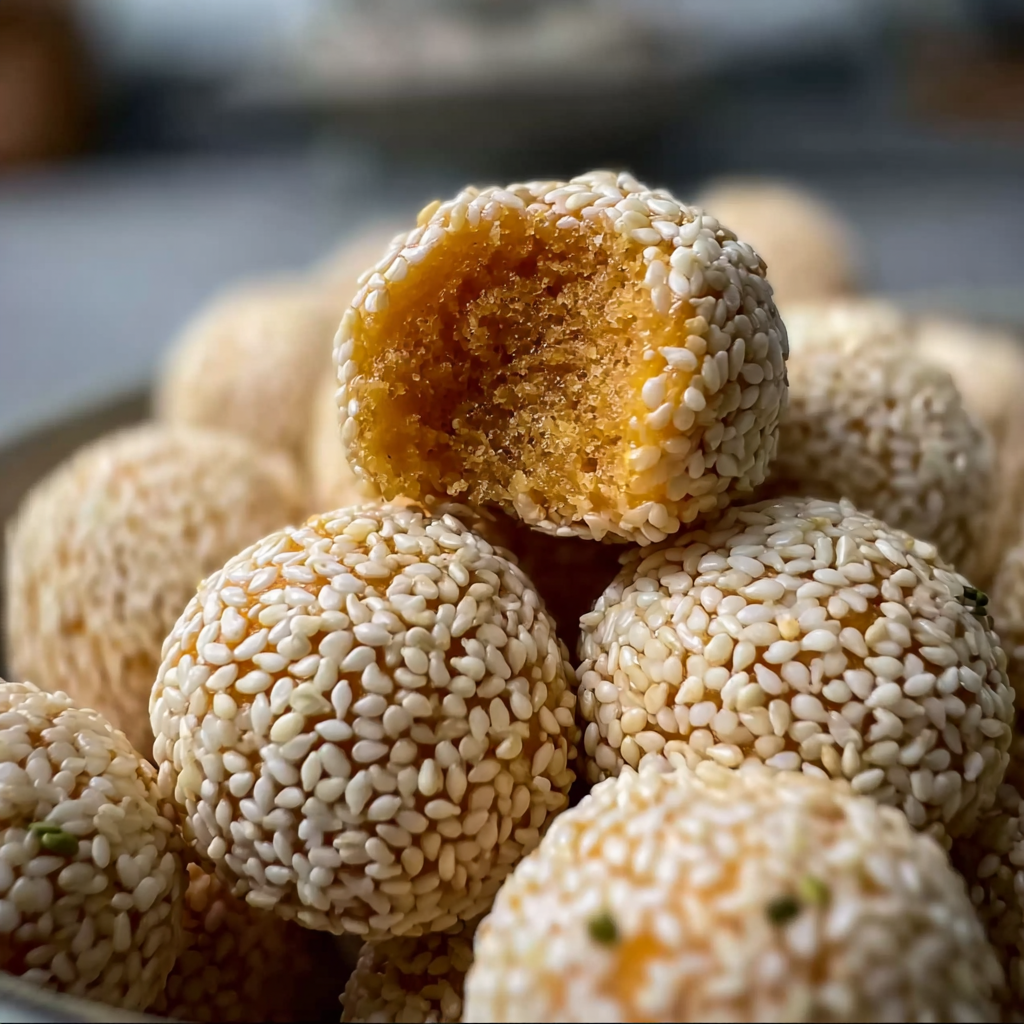
Nutrition & Health Facts for Crispy Sesame Ball Recipe
Are Fried Crispy Sesame Ball Recipe Good for You? Let’s Break It Down
It’s no secret that sesame balls are fried, sweet, and downright delicious—but does that mean they’re off-limits if you’re trying to eat mindfully? Not necessarily. Like many traditional snacks, the crispy sesame ball recipe offers both indulgence and nutritional value—if you know what to look for.
Let’s start with the facts: a typical sesame ball is made from glutinous rice flour, a natural starch that’s gluten-free and easy to digest for many people. It’s filled with lotus paste or red bean paste, which are plant-based and rich in fiber and minerals. The outer layer is coated in sesame seeds, which are loaded with heart-healthy fats, calcium, magnesium, and antioxidants.
However, there’s no denying the oil. Sesame balls are deep-fried, and while the dough doesn’t absorb a ton of oil if cooked properly, the calories do add up.
Nutrition Snapshot (Per Sesame Ball – Approximate)
| Nutrient | Amount (Estimated) |
|---|---|
| Calories | 180–220 kcal |
| Total Fat | 8–10g (mostly from sesame & frying oil) |
| Carbohydrates | 28–30g |
| Protein | 3–4g |
| Sugar | 8–12g (from filling) |
| Fiber | 1–2g |
As you can see, sesame balls are calorie-dense, but they’re also rich in flavor and texture—meaning you’re likely to feel satisfied after just one or two. They’re certainly more nutritious than many store-bought sweets filled with preservatives and artificial flavors.
Wondering, “Are fried sesame balls good for you?” The honest answer is: they can be, when enjoyed in moderation and made with quality ingredients.
Ways to Make Sesame Balls a Bit Healthier
Love this crispy sesame ball recipe, but want to lighten it up? Here are a few easy changes you can make without sacrificing flavor:
- Bake or Air Fry: While traditionalists may scoff, baking or air frying can cut down significantly on added fat. They won’t puff as much but still taste great.
- Use less sugar in the dough or filling. You can even make your own lotus or red bean paste and control the sweetness yourself.
- Try smaller portions: Make 10–12 smaller balls instead of 8. You get more bites and easier portion control.
- Use alternative fillings like mashed dates, almond butter, or unsweetened coconut. These lower the glycemic load and add natural sweetness.
Balancing Tradition with Wellness
Cultural foods like sesame balls aren’t just about ingredients—they carry heritage, celebration, and joy. Rather than cutting them out, think about when and how you enjoy them. Having a few fresh, homemade sesame balls during Lunar New Year or with family on a weekend? That’s a nourishing experience in more ways than one.
Creative Variations of the Crispy Sesame Ball Recipe
Beyond the Basics: Reimagining a Classic Favorite
Once you’ve mastered the original crispy sesame ball recipe, it’s time to explore how this traditional treat can be reinvented. Whether you’re aiming for a plant-based option, modern flavor twist, or just a more fun format, sesame balls are surprisingly versatile. From supersized versions to filling-free bites, there’s no shortage of ways to make them your own.
Let’s explore some exciting takes that still respect the roots of this beloved snack while appealing to today’s creative cooks.
Giant Sesame Balls: A Bold, Impressive Twist
Craving something with a dramatic presentation? Enter the giant sesame ball recipe—a mega-sized version of the traditional favorite that’s perfect for parties or as a centerpiece dessert.
How to do it:
- Double your dough and filling portions.
- Shape one large ball (about the size of a grapefruit).
- Fry gently at a lower oil temperature (around 300°F) for a longer time (20–25 minutes), constantly rotating and pressing it to ensure even puffing.
The result? A crackling golden crust with a soft, chewy interior—and a serious wow factor.
Vegan Sesame Balls: 100% Plant-Based Delight
The original sesame ball recipe is already plant-friendly—no eggs or dairy required. But to go fully vegan, pay close attention to the filling and frying oil:
- Filling options: Use homemade red bean paste, date and almond puree, or sweetened mashed sweet potato.
- Oil: Choose high-smoke-point, non-GMO vegetable oils or avocado oil.
- Sweeteners: Use maple syrup or coconut sugar in your homemade filling for natural sweetness.
This variation fits right in with a growing demand for plant-based Asian desserts that don’t skimp on taste or texture.
Crispy Sesame Ball Recipe Without Filling – Still Crispy, Still Irresistible
Don’t feel like making filling? No problem. The sesame balls no filling version is just as addictive. These bite-sized snacks are simpler to prepare and fry even faster.
How to do it:
- Roll the dough into smaller balls (about 1 inch wide).
- Skip the filling step and go straight to sesame coating.
- Fry at 320°F until golden and puffy, usually 6–8 minutes.
They’re perfect for dipping in honey, matcha glaze, or even a dark chocolate drizzle. You’ll often find people searching for “easy crispy sesame ball recipe” and this variation fits that bill perfectly.
Flavor-Infused Dough and Fillings
Ready to go gourmet? Try infusing your dough or filling with unique flavors:
| Flavor Add-In | Where to Add It | Taste Impact |
|---|---|---|
| Matcha Powder | Into the dough | Earthy, slightly bitter contrast |
| Cocoa Powder | Into the dough | Rich, chocolatey shell |
| Crushed Peanuts | Into the filling | Nutty and crunchy |
| Pandan Extract | Into the dough | Sweet, floral, tropical aroma |
| Coconut Milk | Into the filling | Creamy, smooth texture boost |
These additions give your sesame balls a flavor upgrade without complicating the recipe too much.
Air-Fried Sesame Balls – Crisp Without the Oil
Want to lighten things up? You can prepare sesame balls in an air fryer:
- Preheat the air fryer to 350°F.
- Spray the sesame-coated balls lightly with oil spray.
- Cook for 8–10 minutes, shaking halfway through.
They won’t puff as dramatically as deep-fried ones, but you’ll still get a crispy, golden surface and warm, sweet interior. It’s an ideal option for guilt-free snacking or healthier entertaining.
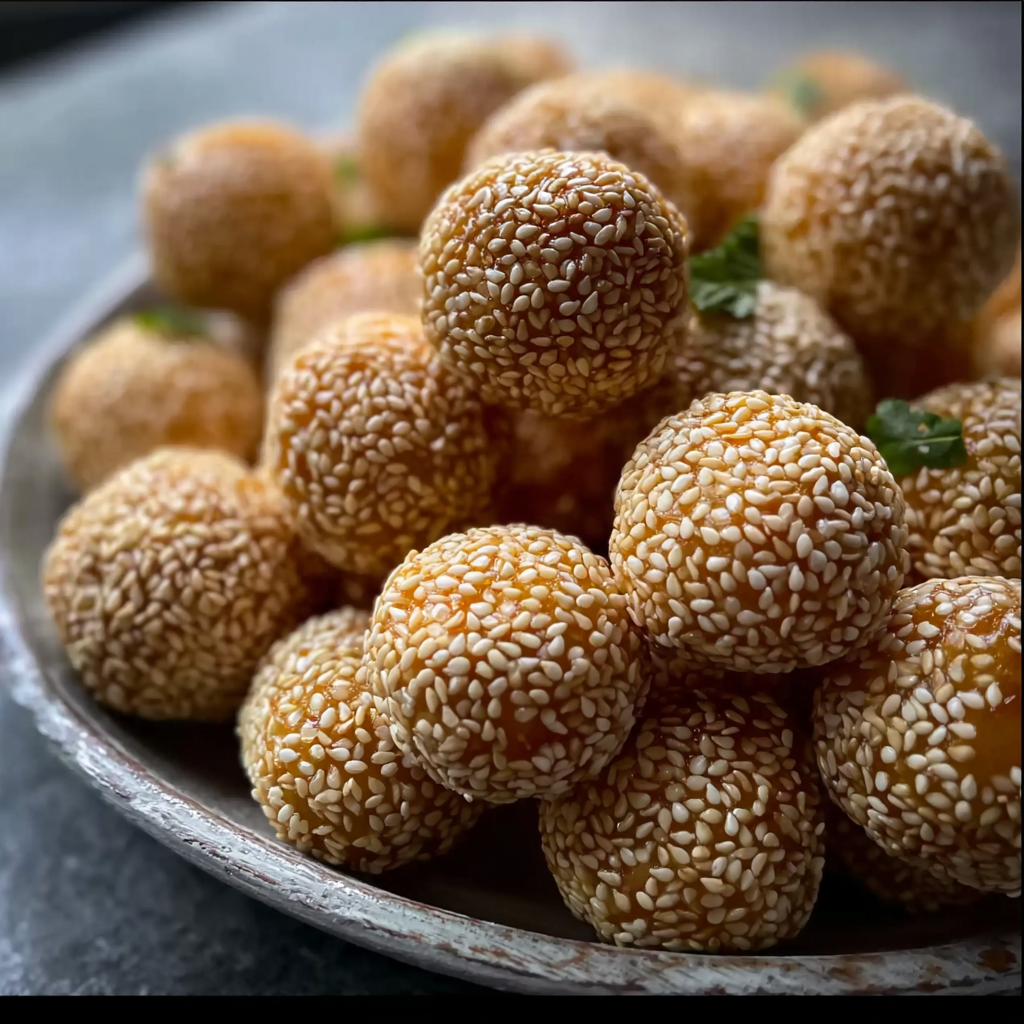
A Golden Treat That Never Gets Old
The crispy sesame ball recipe isn’t just a snack—it’s a culinary experience filled with history, culture, texture, and creativity. From the smooth lotus or red bean center to the golden crust speckled with nutty sesame seeds, every bite offers comfort and delight.
We’ve explored every angle—from shaping, filling, and frying to healthier alternatives like air frying and exciting twists like giant or no-filling versions. Whether you’re making traditional Chinese Crispy Sesame Ball Recipe, Filipino-style buchi, or crafting a modern vegan variation, you now have the tools, tips, and techniques to master this timeless treat.enjoy this recipe Crispy Sesame Ball Recipe and Tray this : Energy Balls
What is buchi made of?
Buchi, the Filipino version of sesame balls, is made with the same base—glutinous rice flour dough, a sweet paste filling, and a sesame seed coating, then deep-fried to golden perfection.
What’s in the middle of a sesame ball?
The traditional center contains lotus seed paste or red bean paste. Some modern variations include chocolate, peanut butter, or mashed sweet potatoes for a creative spin.
Are fried sesame balls good for you?
While fried sesame balls are calorie-rich due to the oil and sweet filling, they do offer nutritional value from sesame seeds (healthy fats and minerals) and plant-based fillings. Enjoy them in moderation as part of a balanced diet.
What are the ingredients in a sesame ball?
Sesame balls are made from a simple dough using glutinous rice flour, sugar, and water. They’re filled with lotus paste or red bean paste, then coated with raw or toasted sesame seeds before deep frying. Peanut or vegetable oil is used for frying.

